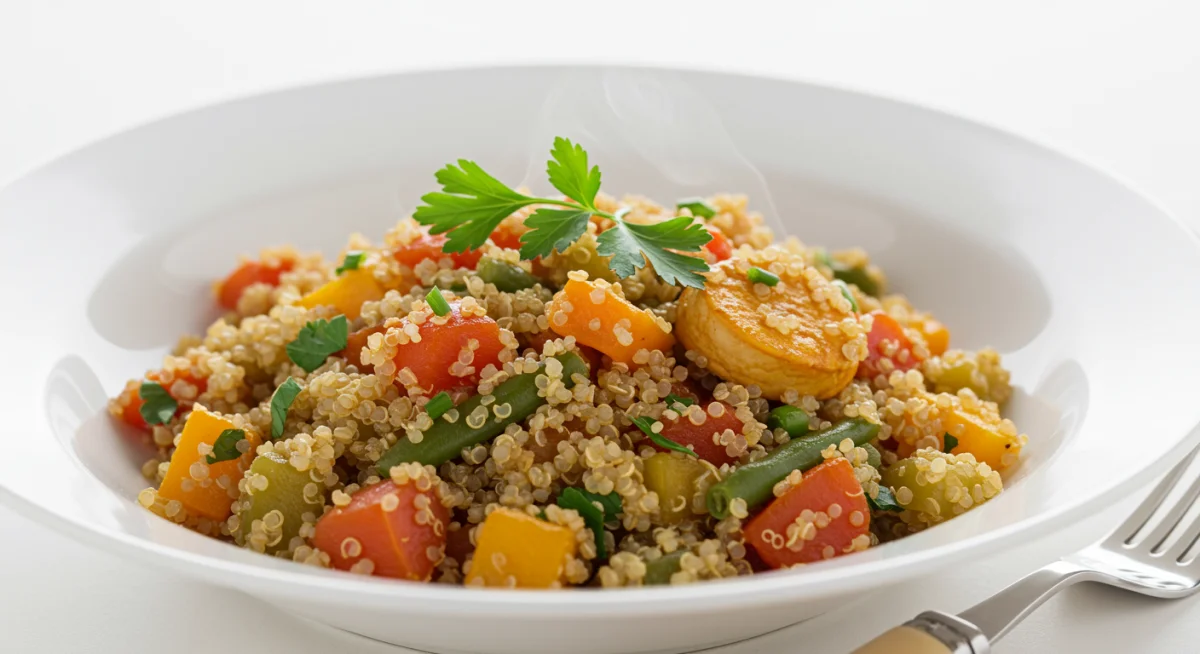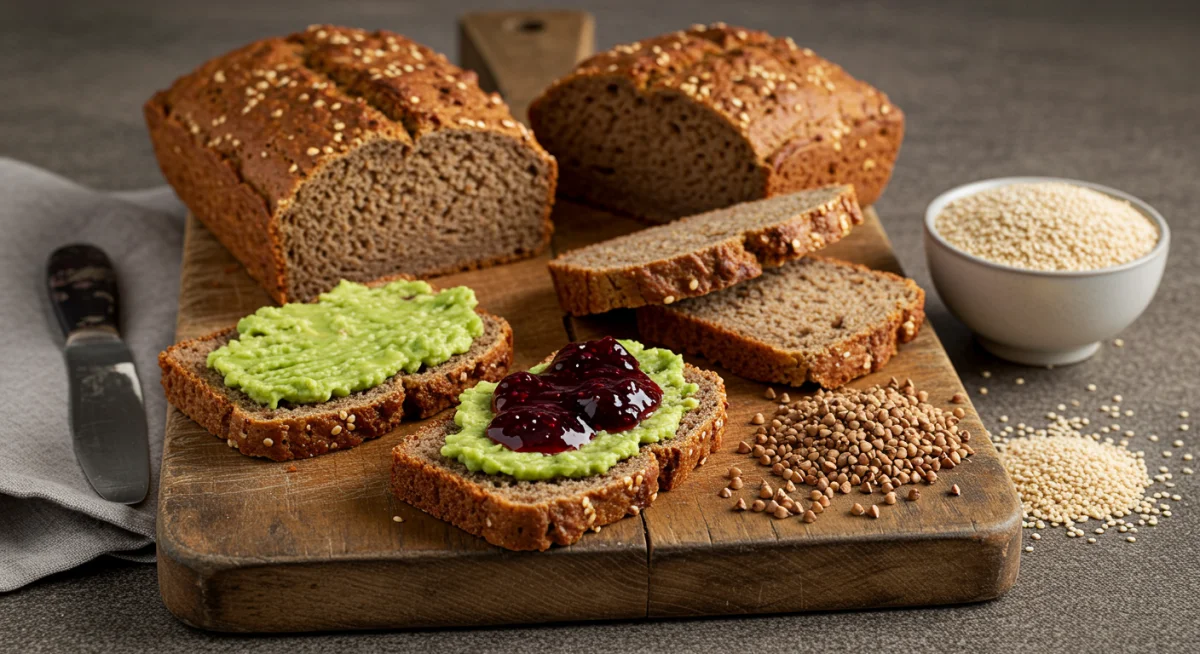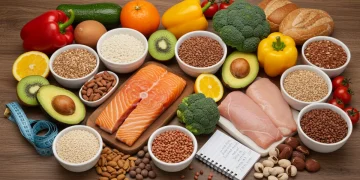2025 Guide: Gluten-Free Grains & 7 Innovative Recipes

The 2025 guide to gluten-free grains highlights quinoa, amaranth, and buckwheat, offering seven innovative recipes to seamlessly integrate these nutritious options into diverse dietary plans for enhanced well-being.
Welcome to the definitive 2025 Guide to Gluten-Free Grains: 7 Innovative Recipes to Incorporate Quinoa, Amaranth, and Buckwheat into Your Diet. As awareness of dietary sensitivities grows, embracing nutritious gluten-free alternatives has become more important than ever. This guide will help you navigate the world of wholesome grains, offering creative ways to enhance your meals and overall health.
Understanding the Gluten-Free Landscape in 2025
The landscape of dietary health is continuously evolving, and 2025 marks a significant shift towards more informed and inclusive eating habits. As more individuals identify with gluten sensitivities, celiac disease, or simply choose a gluten-free lifestyle for perceived health benefits, the demand for diverse and delicious gluten-free options has skyrocketed. This isn’t just a trend; it’s a fundamental change in how we approach nutrition, prioritizing ingredients that support digestive health and overall vitality.
Many people are surprised to learn that ‘gluten-free’ doesn’t mean ‘flavor-free’ or ‘nutrient-deficient.’ In fact, it opens up a world of ancient grains that are packed with essential nutrients, offering unique textures and flavors that can elevate any meal. The challenge often lies in knowing which grains to choose and how to prepare them in ways that are both appealing and easy to integrate into daily cooking routines. This guide aims to demystify these grains, providing a clear path to enjoying a rich and varied gluten-free diet.
The Rise of Ancient Grains
The resurgence of ancient grains like quinoa, amaranth, and buckwheat is a testament to their enduring nutritional value and versatility. These grains have been staples in various cultures for centuries, long before modern agricultural practices dominated. Their natural resilience and robust nutrient profiles make them ideal candidates for a healthy, gluten-free diet. Understanding their origins and benefits helps appreciate their place in contemporary cooking.
- Quinoa: Often called a ‘superfood,’ quinoa is a complete protein, meaning it contains all nine essential amino acids. It’s also rich in fiber, magnesium, B vitamins, iron, potassium, calcium, phosphorus, vitamin E, and various beneficial antioxidants.
- Amaranth: A tiny, powerhouse grain, amaranth is also a complete protein and an excellent source of lysine, an amino acid often lacking in other grains. It boasts high levels of fiber, iron, magnesium, phosphorus, and manganese, supporting bone health and energy production.
- Buckwheat: Despite its name, buckwheat is not related to wheat; it’s a fruit seed related to rhubarb. It’s high in fiber, protein, and routine, a powerful antioxidant. Buckwheat is known for its ability to improve heart health and help manage blood sugar levels.
Incorporating these grains into your diet can significantly enhance your nutrient intake, providing sustained energy and supporting various bodily functions. This section lays the groundwork for exploring their practical applications, moving beyond simple facts to actionable culinary advice.
Quinoa: The Complete Protein Powerhouse
Quinoa, pronounced ‘keen-wah,’ has cemented its place in healthy eating circles for good reason. Originating from the Andes, this pseudocereal offers a remarkable nutritional profile, making it a staple for anyone seeking a wholesome, gluten-free diet. Its mild, slightly nutty flavor and fluffy texture make it incredibly versatile, adaptable to a wide array of dishes from breakfast to dinner.
Beyond its impressive protein content, quinoa is a fantastic source of dietary fiber, which is crucial for digestive health and maintaining stable blood sugar levels. It also provides a significant amount of iron, important for oxygen transport in the blood, and magnesium, vital for muscle and nerve function. For those managing celiac disease or gluten sensitivity, quinoa offers a safe and nutrient-dense alternative to traditional grains like wheat, barley, and rye.
Versatile Quinoa Applications
The beauty of quinoa lies in its adaptability. It can be a simple side dish, a base for salads, or a hearty addition to soups and stews. Cooking quinoa is straightforward, typically requiring a 1:2 ratio of quinoa to water and about 15 minutes of simmering. Once cooked, it expands and becomes light and fluffy, perfect for absorbing flavors from other ingredients.
- Breakfast Bowls: Cooked quinoa can be served warm with fruit, nuts, and a drizzle of honey or maple syrup for a protein-packed start to the day.
- Salad Base: Replace lettuce with cooked and cooled quinoa for a more substantial salad that holds up well for meal prepping. Add roasted vegetables, chickpeas, and a lemon-tahini dressing.
- Savory Side Dish: Season cooked quinoa with herbs, spices, and a touch of olive oil to complement grilled chicken, fish, or plant-based proteins.
Experimenting with different colored quinoas—white, red, and black—can also add visual appeal and subtle variations in texture to your meals. White quinoa tends to be the fluffiest, while red and black varieties offer a chewier texture and a slightly earthier flavor. Regardless of the type, quinoa remains an excellent choice for a balanced and delicious gluten-free diet.

Amaranth: The Ancient Superseed
Amaranth, a tiny grain with a mighty nutritional punch, traces its roots back to ancient Aztec civilizations where it was revered as a superfood. This pseudocereal is not only naturally gluten-free but also boasts an exceptional nutritional profile that makes it a standout among healthy grains. Its small, pearl-like seeds pop when cooked, creating a unique texture that can add intrigue to various dishes.
One of amaranth’s most significant advantages is its complete protein content, including lysine, an amino acid often scarce in other plant-based proteins. This makes it an invaluable asset for vegetarians, vegans, and anyone looking to boost their protein intake without relying on animal products. Furthermore, amaranth is rich in dietary fiber, iron, magnesium, phosphorus, and manganese, all crucial for maintaining robust health.
Culinary Uses and Nutritional Benefits
Amaranth’s versatility extends from savory to sweet preparations. It can be cooked as a porridge, added to baked goods, or even popped like popcorn for a healthy snack. Its slightly peppery, nutty flavor pairs well with a variety of ingredients, making it an exciting addition to any gluten-free kitchen. Cooking amaranth is similar to quinoa, typically requiring a 1:2.5 or 1:3 ratio of amaranth to liquid, simmering until the liquid is absorbed and the grains are tender.
- Porridge: Cook amaranth with milk or plant-based milk, then mix with fruits, nuts, and a touch of cinnamon for a hearty breakfast.
- Thickener: Its ability to thicken liquids makes it an excellent addition to soups, stews, and sauces, adding both nutrients and a creamy texture.
- Baked Goods: Amaranth flour can be used in gluten-free baking to add protein and a unique flavor to bread, muffins, and cookies.
Beyond its culinary applications, amaranth offers notable health benefits. Its high fiber content aids digestion and can help regulate blood sugar levels, while its iron content is crucial for preventing anemia. The presence of antioxidants also contributes to overall cellular health, making amaranth a truly holistic food choice. Integrating amaranth into your diet is a simple yet effective way to enhance both flavor and nutrition.
Buckwheat: The Heart-Healthy Pseudocereal
Buckwheat, despite its misleading name, is not a type of wheat but rather a fruit seed related to rhubarb, making it inherently gluten-free and safe for those with celiac disease or gluten sensitivity. This ancient pseudocereal is celebrated for its distinctive earthy flavor and numerous health benefits, particularly its positive impact on cardiovascular health. It’s a staple in many Eastern European and Asian cuisines, valued for both its culinary versatility and nutritional density.
One of buckwheat’s most impressive attributes is its high content of rutin, a flavonoid antioxidant known for its ability to strengthen blood vessels and improve circulation. This makes buckwheat a particularly beneficial food for heart health. Additionally, it’s a good source of dietary fiber, protein, and essential minerals like magnesium, manganese, and phosphorus, contributing to overall well-being and sustained energy levels.
Exploring Buckwheat in the Kitchen
Buckwheat is available in several forms, each offering unique culinary possibilities. Kasha, or roasted buckwheat groats, has a more intense, nutty flavor and a firmer texture, often used in savory dishes. Unroasted groats are milder and softer when cooked, ideal for porridges or as a rice substitute. Buckwheat flour is a popular gluten-free alternative for baking, lending a robust flavor to pancakes, noodles, and bread.
- Kasha Pilaf: Sauté kasha with onions, mushrooms, and vegetable broth for a hearty and flavorful side dish.
- Buckwheat Pancakes: Use buckwheat flour to make light and fluffy pancakes, a traditional favorite often served with fruit and maple syrup.
- Soba Noodles: While often a blend, 100% buckwheat soba noodles are a delicious gluten-free option for stir-fries and cold noodle salads.
The fiber in buckwheat aids in digestive health and helps to regulate blood sugar, making it an excellent choice for individuals looking to manage their glucose levels. Its protein content also contributes to satiety, helping to keep hunger at bay. Embracing buckwheat in your diet is a flavorful way to support heart health and enjoy a diverse range of gluten-free meals.

7 Innovative Gluten-Free Grain Recipes for 2025
Integrating new grains into your diet can sometimes feel daunting, but with these innovative recipes, you’ll find it both easy and delicious. These recipes are designed to showcase the unique qualities of quinoa, amaranth, and buckwheat, transforming them into exciting and nutritious meals that cater to various tastes and occasions. Each recipe emphasizes flavor, ease of preparation, and maximum nutritional benefit.
From vibrant salads to comforting main courses and even a sweet treat, this collection aims to inspire your gluten-free culinary adventures. We’ve focused on combining these grains with fresh, wholesome ingredients to create balanced meals that are not only good for you but also incredibly satisfying. Get ready to expand your recipe repertoire and discover new family favorites.
Recipe Breakdown and Preparation Tips
Each recipe provides clear instructions and highlights key ingredients, making it simple to follow along. We’ve also included tips for meal prepping and ingredient substitutions to ensure flexibility and convenience. The goal is to empower you to confidently cook with these grains, adapting them to your personal preferences and dietary needs.
- Quinoa & Roasted Vegetable Medley: A colorful and nutrient-dense dish featuring fluffy quinoa tossed with seasonal roasted vegetables like bell peppers, zucchini, and cherry tomatoes, seasoned with Mediterranean herbs and a lemon vinaigrette. Perfect for a light lunch or a vibrant side.
- Amaranth Breakfast Power Bowl: Creamy amaranth cooked with almond milk, topped with fresh berries, sliced almonds, chia seeds, and a drizzle of maple syrup. A warm and energizing start to your day.
- Buckwheat & Mushroom Risotto (Gluten-Free): A hearty and earthy risotto-style dish made with unroasted buckwheat groats, sautéed mushrooms, garlic, and vegetable broth, finished with a sprinkle of nutritional yeast for a cheesy flavor.
- Spicy Quinoa and Black Bean Burgers: Flavorful and protein-packed patties made from cooked quinoa, black beans, corn, and a blend of spices, served on gluten-free buns with avocado and salsa.
- Amaranth & Spinach Stuffed Bell Peppers: Bell peppers filled with a savory mixture of cooked amaranth, fresh spinach, diced tomatoes, and herbs, then baked until tender. A beautiful and satisfying main course.
- Buckwheat Noodle Salad with Peanut Dressing: Chilled 100% buckwheat soba noodles tossed with crisp vegetables like shredded carrots, cucumber, and bell peppers, coated in a creamy and tangy peanut dressing. Ideal for a refreshing meal.
- Quinoa & Apple Cinnamon Bake: A delightful sweet treat or breakfast option, combining cooked quinoa with diced apples, cinnamon, nutmeg, and a touch of brown sugar, baked until golden and bubbly.
These recipes demonstrate the incredible versatility of gluten-free grains. Don’t be afraid to experiment with different seasonings and vegetables to tailor these dishes to your liking. The journey of discovering new flavors and textures is one of the most rewarding aspects of healthy cooking.
Meal Prepping with Gluten-Free Grains
Meal prepping has become an indispensable strategy for maintaining a healthy diet, especially when navigating gluten-free requirements. Preparing meals in advance not only saves time during busy weekdays but also ensures you have nutritious, compliant options readily available, reducing the temptation for less healthy choices. Gluten-free grains like quinoa, amaranth, and buckwheat are exceptionally well-suited for meal prepping due to their stability and versatility when cooked.
The key to successful gluten-free meal prepping lies in efficient cooking and smart storage. Cooking a large batch of your chosen grain at the beginning of the week can provide a versatile base for multiple meals. These grains store well in the refrigerator for several days and can be easily incorporated into various dishes, from salads and bowls to stir-fries and side dishes. This proactive approach helps to streamline your healthy eating efforts.
Tips for Efficient Grain Preparation and Storage
To maximize the benefits of meal prepping with gluten-free grains, consider these practical tips. Proper preparation and storage are crucial for maintaining freshness, flavor, and food safety. A little planning can go a long way in ensuring your gluten-free meals are always delicious and convenient.
- Batch Cook Grains: Cook a larger quantity of quinoa, amaranth, or buckwheat than you need for a single meal. Once cooled, divide it into individual portions or store it in a large airtight container in the refrigerator for up to 4-5 days.
- Flavor Infusion: Cook grains in vegetable or chicken broth instead of water to add a deeper layer of flavor that will enhance your prepped meals. You can also add herbs and spices during cooking.
- Component Prep: Instead of fully assembled meals, prep individual components. Cooked grains, roasted vegetables, and protein sources (like grilled chicken or tofu) can be stored separately and combined just before serving to maintain optimal texture and freshness.
- Freezing for Longevity: Cooked grains can be frozen for longer storage. Spread them in a single layer on a baking sheet to freeze individually, then transfer to a freezer-safe bag or container. This prevents clumping and allows you to use only what you need.
By adopting these meal prepping strategies, you can significantly simplify your gluten-free diet, ensuring a consistent supply of healthy and delicious meals. The convenience of having pre-cooked grains at hand makes it much easier to stick to your dietary goals and enjoy the rich nutritional benefits of quinoa, amaranth, and buckwheat without daily extensive cooking.
Beyond the Plate: Health Benefits and Dietary Considerations
While the culinary versatility of gluten-free grains is undeniable, their profound health benefits extend far beyond just taste and texture. Incorporating quinoa, amaranth, and buckwheat into your diet offers a holistic approach to wellness, addressing various nutritional needs and supporting long-term health. Understanding these benefits can further motivate their consistent inclusion in your meals.
For individuals with celiac disease or non-celiac gluten sensitivity, these grains are lifesavers, providing safe and nutritious alternatives that prevent digestive distress and nutrient deficiencies. However, their advantages aren’t limited to those with gluten issues. Everyone can benefit from their rich fiber content, complete protein profiles, and abundance of vitamins and minerals, which contribute to improved digestion, sustained energy, and chronic disease prevention.
Comprehensive Health Advantages
The impact of these grains on overall health is significant. Their nutrient density means you’re getting more bang for your buck in terms of vitamins, minerals, and beneficial compounds. This section details some of the key health advantages associated with regular consumption of quinoa, amaranth, and buckwheat.
- Digestive Health: High fiber content in all three grains promotes regular bowel movements, prevents constipation, and supports a healthy gut microbiome, which is crucial for overall immunity and well-being.
- Blood Sugar Regulation: The complex carbohydrates and fiber help to slow down sugar absorption, preventing sharp spikes and crashes in blood glucose levels, which is particularly beneficial for individuals managing diabetes or seeking stable energy.
- Heart Health: Buckwheat, in particular, is noted for its rutin content, which supports cardiovascular health by strengthening blood vessels. All three grains contribute to lower cholesterol levels due to their fiber and plant sterols.
- Weight Management: The combination of protein and fiber promotes satiety, helping you feel fuller for longer and potentially reducing overall calorie intake, aiding in weight management efforts.
- Antioxidant Power: Quinoa, amaranth, and buckwheat are rich in various antioxidants that combat oxidative stress, protecting cells from damage and reducing the risk of chronic diseases.
When making dietary changes, it’s always wise to consider individual needs. While these grains are generally safe and beneficial, those with specific health conditions or allergies should consult with a healthcare professional or registered dietitian. This ensures that their dietary choices align with their personal health goals and requirements, maximizing the benefits without adverse effects. The journey to a healthier lifestyle is personal, and informed choices are its cornerstone.
| Key Grain | Primary Benefit & Use |
|---|---|
| Quinoa | Complete protein source, versatile in salads and main dishes. |
| Amaranth | High in lysine and minerals, great for porridges and thickening. |
| Buckwheat | Heart-healthy, rich in rutin, used in pancakes and noodles. |
| Gluten-Free Diet | Supports digestive health and provides diverse nutrient intake. |
Frequently Asked Questions About Gluten-Free Grains
Incorporating gluten-free grains like quinoa, amaranth, and buckwheat offers numerous benefits, including improved digestion due to high fiber, complete protein sources for muscle health, and a rich array of essential vitamins and minerals. They also help stabilize blood sugar levels and support cardiovascular health.
Yes, quinoa, amaranth, and buckwheat are naturally gluten-free and generally safe for individuals with celiac disease. However, it is crucial to ensure that these grains are certified gluten-free to avoid cross-contamination during processing and packaging.
You can easily substitute these grains in many recipes. Quinoa can replace rice or couscous in salads and side dishes. Amaranth can be used in porridges instead of oats. Buckwheat groats make a great alternative to rice or barley in pilafs, while buckwheat flour works well in gluten-free baking.
A common misconception is that all gluten-free products are inherently healthy; some can be highly processed. Another is that gluten-free grains lack flavor or versatility. In reality, grains like quinoa, amaranth, and buckwheat are highly nutritious and offer diverse culinary applications when prepared correctly.
Yes, children can safely consume quinoa, amaranth, and buckwheat as part of a balanced diet. These grains provide essential nutrients vital for growth and development. Always introduce new foods gradually and consult with a pediatrician if there are concerns about allergies or specific dietary needs.
Embracing a Healthier, Gluten-Free Future
As we navigate 2025, the focus on mindful eating and personalized nutrition continues to grow. The journey through the world of gluten-free grains, specifically quinoa, amaranth, and buckwheat, reveals a wealth of culinary possibilities and profound health benefits. These ancient grains offer more than just safe alternatives for those avoiding gluten; they provide a pathway to a richer, more diverse, and nutrient-dense diet for everyone. By embracing their unique flavors and textures, and utilizing innovative recipes, you can transform your meals into exciting, wholesome experiences.
The information and recipes shared in this guide are designed to empower you with the knowledge and inspiration to confidently integrate these powerful grains into your daily life. Whether you’re managing a dietary restriction or simply seeking to enhance your well-being, quinoa, amaranth, and buckwheat stand out as excellent choices. Their contributions to digestive health, heart function, and overall vitality are undeniable, proving that a gluten-free diet can be both delicious and incredibly beneficial. Here’s to a future filled with vibrant, healthy, and satisfying meals, one gluten-free grain at a time.





